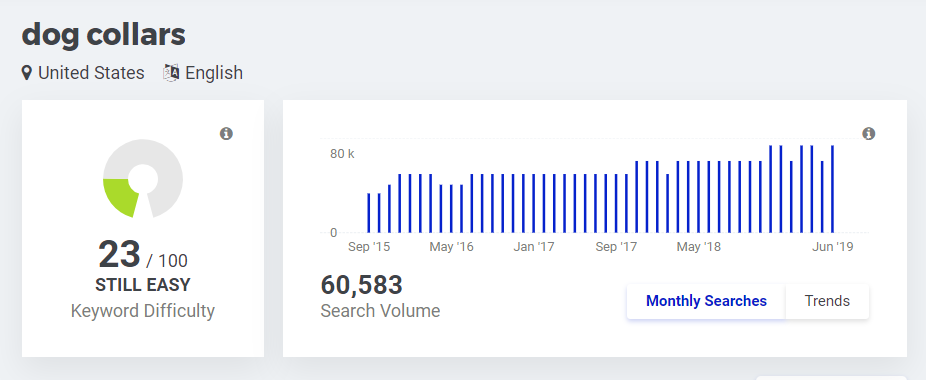SEO Keyword Research – Best Practices You Should Know
Keyword research and key phrases are still an extremely important element of SEO. However, their roles and usage techniques are constantly changing. When I started my adventure with SEO about 10 years ago, then it was en vogue to stuff keywords everywhere on the page, wherever you could add them: content, metadata, footer, not taking […]

Keyword research and key phrases are still an extremely important element of SEO. However, their roles and usage techniques are constantly changing. When I started my adventure with SEO about 10 years ago, then it was en vogue to stuff keywords everywhere on the page, wherever you could add them: content, metadata, footer, not taking the fact that this content is unreadable for the user into consideration. What’s worse, the supporters of black hat SEO were then willing to hide the keywords in the code using the smallest font or background color, so that the user could not see the text, while the robot could find it in the Html code. Today, of course, such actions are unacceptable, and the use of keywords is also different than it was before.
Today’s article I would like to devote to the SEO keyword research, role and types of keywords, and good practices related to their application from the SEO point of view.
Keywords – What They Are
Keywords play a crucial role in the SEO world. SEO strategies are often built based on them. Then their positions in the search results are a determinant of the results achieved. Of course, SEO is not based solely on key phrases, and the goal is usually qualitative organic traffic, not the positions themselves. There is no doubt, however, that without measuring the position of key business phrases, it is difficult to estimate results or plan further SEO strategies.
So What Are the Keywords?
They are nothing more than expressions that users type in the search engine looking for specific information. In its results, the search engine presents the pages that its algorithm has linked to the given keyword. In short, this means that the search engine assigns a given subpage as adequate to the user’s query for a given expression entered by users in the search field. Therefore, there is a high probability that they will find the information they are looking for. If your site is not optimized for keywords, with which your potential audience searches for information on the Internet, your chances of appearing in the search results are almost none.
Example: If we run a food store and accessories for dogs, the keywords with the help of which users can reach your site can be:
- Best dog food (search volume: 60,500)
- Toys for dogs (search volume: 40,900)
- Dry food for dogs (search volume: 2,400)
- Dog food online (search volume: 2,300).
You can find plenty of those kinds of keywords that describe your business and are relevant to the queries used by your potential clients while searching online for products for dogs. The more adequate keywords you find, the bigger the range of your offer you can expect to be shown in the search engine. So make sure you prepare the proper SEO keyword research!
SEO Keyword Research Tools
If you want to perform thorough SEO keyword research, I highly recommend the tools below:
- neilpatel.com/ubersuggest – this is a free keyword research tool provided by marketing guru Neil Patel;
- keyword-planner – this is a tool you can access if you run a Google Ads campaign, you can see a specific search volume for the particular key phrase there instead of “from … to” that most tools often provide.
- Kwfinder – this is a tool provided by Mangools. It is not free of charge but it is really useful in everyday SEO work, especially while doing an SEO keyword research.
Moreover, if you want to know more about keyword tracking tools – check out this article!
Types of Keywords
There are several various types of keywords that I’d like to describe and which I use in my everyday SEO work. I divided them into 4 groups depending on the characteristics. Let’s have a look!
1) Keywords Length (Number of Words)
We can distinguish two types of keywords in this group.
Short-tail Keywords
They are general and contain up to three words. Short-tail keywords have a high monthly search volume that’s why they are attractive, but also very competitive. This means if you want to rank high with these keywords, you need will do the hard work and wait patiently because the results won’t come fast.
Examples:
- Dog food (search volume: 110,4550)
- Pet food (search volume: 14,800)
- Dog collars (search volume: 60,500)
Long-tail Keywords
As opposed to short-tail ones, these are more specific keywords with more than 3 words. The average monthly search volume makes them less competitive. Therefore, it is easier to rank high for them. We can usually do basic work and can begin to see the results after a few weeks.
Examples:
- Best dog food for puppies (search volume: 6,600)
- Bark collar for small dogs (search volume: 4,400)
- Best dog food for allergies (search volume: 4,300)
2) The Intention of the Query
This group contains key phrases divided by the purpose of the search.
Branded Keywords
It seems obvious that these keywords include the name of the brand or company, which the searcher recognizes or wants to get more information about. Usually, when your brand is popular, your website is always in the top 1 for dedicated branded keywords. But in other cases, if you’ve already started your promotion, you might not be the top 1 or even the top 3, if your brand name is a popular word with few meanings.
Examples:
- royal canin puppy food (search volume: 22,100)
- purina dog food (search volume: 33,100)
- pedigree dog food (search volume: 18,100)
Non-branded Keywords
As the name suggests, they don’t contain a brand’s name in the phrase. This basically means that these are all other keywords relating to the products, services and any topic (both short and long-tail ones and those I will describe below).
Examples:
- Puppy food (search volume: 9,900)
- Dry dog food (search volume: 3,700)
- Pet shop (search volume: 33,100)
3) Period of Popularity
This group includes keywords that refer to how long or when they are popular.
Seasonal Keywords
Their popularity depends on the time, season, holiday or other trends. Therefore, we are interested in them and search for them only during that time. For example, we look for “Halloween decorations” in October, but not necessarily in May. Apart from this “peak time” these keywords have very low or zero popularity.
Examples:
Dog coats (search volume: 49,500 in November / 1,600 in May)

Cooling mat for dog (search volume: 27,100 in July / 1,600 in November)

Dog christmas gifts (search volume: 14,700 in December / 10 in February)

Evergreen Keywords
These words are “always on top” regardless of the season, month or day of the week. They are consistently popular, and their search volume is rather stable for the whole year.
Examples:
Dog collars (search volume: 60,500)

Dog leash (search volume: 27,000)

Dog accessories (search volume: 8,000)

4) Range of Distance
This group is dedicated to keywords related to the location.
Local Keywords
As you can easily guess, local keywords refer to a specific place: street, city or country. They are used in the local search. The range of these keywords is limited by the exact location which means that only people who are interested in the local topic use them in the search process.
Examples:
- Pet store upper east side (search volume: 320)
- Pet store staten island (search volume: 480)
- Pet store manhattan (search volume: 590)
Global Keywords
These key phrases cover all the locations and are universal in all places. The “global nature” of these keywords might be seen in a worldwide range (for example they could be branded keywords like coca-cola, USA, etc.) and also within one country.
Examples:
- Pet store online (search volume: 2,900)
- royal canin (search volume: 74,000)
- Dog food (search volume: 110,400)
This division does not mean that the keywords from a specific group cannot exist in other groups.
In fact, all of these key phrases can exist in any configuration depending on the industry and the specifics of the targeted user. For example, the key phrase “Wojas red heels on sale online” is: global, branded, seasonal because of the sale and long-tailed one at once! 😉
What about Question Keywords?
I want to describe question key phrases more broadly. They are becoming more and more important in the SEO world and not only in this industry. Why is that? Because they are essential in the aspects of voice search and its increasing popularity. “Voice assistants are already being used more frequently. The global market of voice search increased by 187% last year, according to Canalys research”. You can read about this in my article on voice search optimization.
What do I mean by question keywords? In general, they are all the key phrases that are used as a natural language and have the construction of questions. They are specific not only for voice search but more and more often in written search. That is why they are important in the aspects of website content optimization. I personally use them while searching for some tips or advice in terms of the specific topics and I am usually satisfied with the results that the search engine provides me.
Examples:
- What is the best dog food (search volume: 4,400)
- Where to buy from dog food (search volume: 720)
- What dog food is grain free (search volume: 480)
LSI – What Does It Mean?
When it comes to the keywords, I couldn’t ignore the role of LSI keywords. LSI stands for latent semantic indexing. This is the method that search engines use to study and compare relationships between different terms and concepts. These key phrases can also be used to improve the SEO of your website. They are related to our basic keywords but in a specific way. In other words, the search engines are smart enough to identify your content’s context and synonyms related to your keywords. Please take note! I don’t mean synonyms, but keywords that are in the “area” of the topic or within the range of interest of the targeted audience.
It’s crucial to use LSI key phrases in your SEO strategy. When you use them, it is easier to match your website with a specific topic by the search engine robots. It’s also important if you want to make your content more natural and build organic visibility and the topic’s authority widely.
Examples for “dog food” keywords:
- What dogs like to eat (search volume: 20)
- Natural pet food (search volume: 580)
- Human food for dogs list (search volume: 50)
You can generate the list of LSI keywords with these tools:
Let’s Practice – Work with Keywords
Now it’s time to talk about using keywords in everyday work. From an SEO point of view, it’s crucial to use keywords within the content in a very smart way, avoiding the temptation of stuffing or creating unnatural messages. But don’t worry. I have prepared some tips that will help you to properly optimize your website with keywords and fully use their potential in the on-site field!
Include Keywords in Metadata
This Html element is very important from an SEO point of view. Keywords in the title could help to rank better and keywords in the description could impact your CTR. Use them wisely. Don’t create a string of keywords to manipulate rankings because Google is smarter than you and won’t hesitate to penalize this bad behavior. Imagine that you are your targeted user. What do you want to see in the search results? What text could encourage you to click and visit the website? If you find the answers, you’ll create perfect metadata.
Use Keywords in the Headers
This is another piece of Html code that should be optimized with the keywords. I used to put the high competitive keywords in the H1 tag and other keywords successively in H2, H3 and so on. Headers are a great place to put question keywords. This can also help your website to rank in voice search results. You can read more about creating fine headers in this article on writing an SEO friendly article.
Unique Content with Well-Researched Key Phrases
I’m sure that we all know that the keywords should be put in the texts on your website. But I have to mention this because I still encounter websites which use a string of keywords or unnatural forms of keywords in the texts probably only for purposes to rank high. This might be effective, but only for a short time. My advice is to use various types of keywords within the texts, short and long-tail, local and global, seasonal and evergreen, question and especially, LSI words. You need to pay a lot of attention to this issue. Create relevant content that is valuable and fully optimized with different types of keywords. And what is important, which is adapted to the targeted audience’s needs and expectations. If you want to make sure that your content is good, do research and read about the biggest copywriting mistakes in order to avoid them.
Images And Keywords Relationship
The alt tag of the image is a perfect place to put keywords, but only under one condition: the image shows the specific word. Don’t try to put the keyword in the alt tag when the image is not related to it. It might be considered black or grey hat SEO and this definitely won’t bring you any good results.
Best Practices from My Experience
Apart from these basic tips of SEO keyword research and using key phrases, I’d like to share several of my best practices with you. They are the results of my experience and might be the inspiration for you on how to optimize your website with key phrases:
- Mix short and long-tail keywords in all of the elements of your website.
- If you use question keywords, consider also using words like ”the best restaurant near me” – this will have a fine voice search impact. But if you do it, you will have to optimize your website with location info – add contact information, maybe even create a Google My Business Page.
- Use competitive keywords within the strongest, from an SEO point of view, subpages of your website, including the main page.
- Provide users with a straight answer regarding the keyword that leads them to your website.
- Don’t use high competitive keywords that are not related to your target audience or topic.
- Bold keywords in the text to help users evaluate whether the text is about what they are searching for. It also makes content more scannable and easier to comprehend.
- Conduct a periodic revision of your keywords to include new ones which have become more popular or relevant since the last time you checked them.
Keywords – The Fundamentals of SEO
I believe you have a better comprehension of the importance of the keywords in regards to SEO and content optimization. They are essential not only for my profession but also because of their impact on social media or Google Ads. No matter what channel you are focusing on, you need to optimize your website with key phrases. As a result, your users are able to find what they are looking for or need. Moreover, they help search engines’ bots to better understand your website, and when they do, they are able to make it appear in the search engines when relevant keywords are entered. But do not forget to make a thorough SEO keyword research first! Therefore, the proper use of key phrases allows you to rank higher and drive more quality traffic to your site. And that is our main goal, isn’t it? 😉


